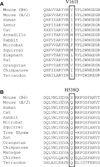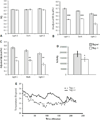The juxtaparanodal proteins CNTNAP2 and TAG1 regulate diet-induced obesity
- PMID: 22752552
- PMCID: PMC3650838
- DOI: 10.1007/s00335-012-9400-8
The juxtaparanodal proteins CNTNAP2 and TAG1 regulate diet-induced obesity
Abstract
Despite considerable effort, the identification of genes that regulate complex multigenic traits such as obesity has proven difficult with conventional methodologies. The use of a chromosome substitution strain-based mapping strategy based on deep congenic analysis overcame many of the difficulties associated with gene discovery and led to the finding that the juxtaparanodal proteins CNTNAP2 and TAG1 regulate diet-induced obesity. The effects of a mild Cntnap2 mutation on body weight were highly dependent on genetic background, as both obesity-promoting and obesity-resistant effects of Cntnap2 were observed on different genetic backgrounds. The more severe effect of complete TAG1 deficiency, by decreasing food intake, completely prevented the weight gain normally associated with high-fat-diet feeding. Together, these studies implicate two novel proteins in the regulation of diet-induced obesity. Moreover, as juxtaparanodal proteins have previously been implicated in various neurological disorders, our results suggest a potential genetic and molecular link between obesity and diseases such as autism and epilepsy.
Figures




References
-
- Bagnasco M, Dube MG, Katz A, Kalra PS, Kalra SP. Leptin expression in hypothalamic PVN reverses dietary obesity and hyperinsulinemia but stimulates ghrelin. Obes Res. 2003;11:1463–1470. - PubMed
Publication types
MeSH terms
Substances
Grants and funding
LinkOut - more resources
Full Text Sources
Medical
Molecular Biology Databases

